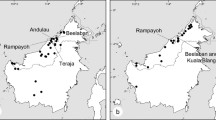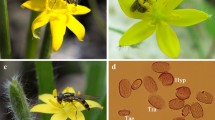Abstract
Most species of Neotropical Malpighiaceae are pollinated by oil-collecting bees of diverse sizes, but the effect of pollinator size on their reproductive success has still not been addressed in the literature. We performed a comparative description of stigma arrangements, analyzing the reproductive system and reproductive success and assessing pollinator sizes in Stigmaphyllon bonariense and Stigmaphyllon jatrophifolium. We collected flowers in three natural populations, conducting pollinator censuses and captures and performing manipulative experiments to determine the plants breeding system. We analyzed the morphology of stigmas and their receptivity and calculated the perimeter of the triangle formed by the stigmas (ST). Pollinator sizes, potential area for pollen transfer (PAPT), and the frequency of visits were also calculated. Stigma arrangement resulted in inverted triangles, and the ST was smaller in S. jatrophifolium than in S. bonariense. The overlap between ST and PAPT suggests that pollinators of all sizes were efficient in pollinating S. jatrophifolium, whereas only large and very large pollinators where efficient in S. bonariense. Moreover, very large pollinators had the highest visit frequencies. Our results indicated that both species are obligate xenogamous, pollinator-dependent, and present pollen limitation. We observed an increase in reproductive success related to the marked turnover in pollinator assemblage throughout the flowering season. These findings suggest that fruit and seed sets vary according to the context of the pollinators and that large pollinators would have the best performance.






Similar content being viewed by others
References
Aliscioni SS, Gotelli M, Torretta JP (2018) Structure of the stigma and style of Callaeum psilophyllum (Malpighiaceae) and its relation with potential pollinators. Protoplasma 255:1433–1442. https://doi.org/10.1007/s00709-018-1245-x
Aliscioni SS, Gotelli M, Torretta JP (2019) Gynoecium with carpel dimorphism in Tricomaria usillo, comparison with other genera of the Carolus clade (Malpighiaceae). Protoplasma 256:1133–1144. https://doi.org/10.1007/s00709-019-01373-3
Almeida RFD, Mamede MCH (2016) Sinopse de Malpighiaceae no Estado do Espírito Santo, Brasil: Stigmaphyllon A. Juss Hoehnea 43:601–633. https://doi.org/10.1590/2236-8906-22/2016
Anderson WR (1979) Floral conservatism in neotropical Malpighiaceae. Biotropica 11:219–223
Anderson WR (1990) The origin of the Malpighiaceae-The evidence from morphology. Mem N Y Bot Gard 64:210–224
Anderson CE (1997) Monograph of Stigmaphyllon (Malpighiaceae). University of Michigan Herbarium
Ashman T-L et al (2004) Pollen limitation of plant reproduction: ecological and evolutionary causes and consequences. Ecology 85:2408–2421. https://doi.org/10.1890/03-8024
Avalos AA, Torretta JP, Lattar EC, Ferrucci MS (2020) Structure and development of anthers and connective glands in two species of Stigmaphyllon (Malpighiaceae): are heteromorphic anthers related to division of labour? Protoplasma 257:1165–1181. https://doi.org/10.1007/s00709-020-01497-x
Barônio GJ, Torezan-Silingardi HM (2017) Temporal niche overlap and distinct bee ability to collect floral resources on three species of Brazilian Malpighiaceae. Apidologie 48:168–180. https://doi.org/10.1007/s13592-016-0462-6
Barônio GJ, de Brito VLG, Nogueira A, Rech AR (2020) Beyond robbery: the role of upside-down behaviour performed by small oil-collecting bees in Malpighiaceae. Arthropod Plant Interact 14:613–621. https://doi.org/10.1007/s11829-020-09770-9
Barros MAG (1992) Fenologia da floração, estrategias reproductivas e polinização de espécies simpátricas do gênero Byrsonima Rich. (Malpighiaceae). Rev Bras Biol 52:343
Bates D, Maechler M, Bolker B, Walker S, Christensen RHB, Singmann H, Dai B, Scheipl F, Green P (2018) Package ‘lme4’. Version, 1,17. CRAN. R Foundation for Statistical Computing, Vienna, Austria
Buchmann SL (1987) The ecology of oil flowers and their bees. Annu Rev Ecol Syst 18:343–369. https://doi.org/10.1146/annurev.es.18.110187.002015
Cane JH (1987) Estimation of bee size using intertegular span (Apoidea). J Kans Entomol Soc 1:145–147
Casey TM, May ML, Morgan KR (1985) Flight energetics of euglossine bees in relation to morphology and wing stroke frequency. J Exp Biol 116:271–289
Collevatti RG, Schoereder JH, Campos LAO (2000) Foraging behavior of bee pollinators on the tropical weed Triumfetta semitriloba: flight distance and directionality. Rev Bras Biol 60:29–37. https://doi.org/10.1590/S0034-71082000000100005
Costa CBN, Costa JAS, Ramalho M (2006) Biologia reprodutiva de espécies simpátricas de Malpighiaceae em dunas costeiras da Bahia, Brasil. Braz J Bot 29:103–114. https://doi.org/10.1590/S0100-84042006000100010
Davis CC, Anderson WR (2010) A complete generic phylogeny of Malpighiaceae inferred from nucleotide sequence data and morphology. Am J Bot 97:2031–2048. https://doi.org/10.3732/ajb.1000146
Davis CC, Schaefer H, Xi Z, Baum DA, Donoghue MJ, Harmon LJ (2014) Long-term morphological stasis maintained by a plant–pollinator mutualism. Proc Natl Acad Sci 111:5914–5919. https://doi.org/10.1073/pnas.1403157111
Edlund AF, Swanson R, Preuss D (2004) Pollen and stigma structure and function: the role of diversity in pollination. Plant Cell 16:S84–S97. https://doi.org/10.1105/tpc.015800
Endress PK (1996) Diversity and evolutionary biology of tropical flowers. Cambridge University Press, Cambridge
Endress PK, Jenny M, Fallen ME (1983) Convergent elaboration of apocarpous gynoecia in higher advanced dicotyledons (Sapindales, Malvales, Gentianales). Nord J Bot 3:293–300. https://doi.org/10.1111/j.1756-1051.1983.tb01941.x
Fenster CB, Armbruster WS, Wilson P, Dudash MR, Thomson JD (2004) Pollination syndromes and floral specialization. Annu Rev Ecol Evol Syst 35:375–403. https://doi.org/10.1146/annurev.ecolsys.34.011802.132347
Fox J, Weisberg S (2019) An R companion to applied regression, 3rd edn. Sage, Thousand Oaks
Greenleaf SS, Williams NM, Winfree R, Kremen C (2007) Bee foraging ranges and their relationship to body size. Oecologia 153:589–596. https://doi.org/10.1007/s00442-007-0752-9
Handel SN (1983) Pollination ecology, plant population structure, and gene flow. Pollination Biology 163:211
Harder LD, Barclay RMR (1994) The functional significance of poricidal anthers and buzz pollination: controlled pollen removal from Dodecatheon. Funct Ecol 8:509–517. https://doi.org/10.2307/2390076
Harder LD, Johnson SD (2009) Darwin’s beautiful contrivances: evolutionary and functional evidence for floral adaptation. New Phytol 183:530–545. https://doi.org/10.1111/j.1469-8137.2009.02914.x
Herrera CM (1987) Gene flow components in Lavandula latifolia Medicus: pollination and seed dispersal. Ann Jard Bot Madrid 44:49–61
Herrera CM (1988) Variation in mutualisms: the spatiotemporal mosaic of a pollinator assemblage. Biol J Linn Soc 35:95–125. https://doi.org/10.1111/j.1095-8312.1988.tb00461.x
Heslop-Harrison J, Heslop-Harrison Y (1985) Surfaces and secretions in the pollen–stigma interaction: a brief review. J Cell Sci 1985:287–300. https://doi.org/10.1242/jcs.1985.Supplement_2.15
Hirao AS (2010) Kinship between parents reduces offspring fitness in a natural population of Rhododendron brachycarpum. Ann Bot 105:637–646. https://doi.org/10.1093/aob/mcq018
Johnson SD, Steiner KE (2000) Generalization versus specialization in plant pollinator systems. Trends Ecol Evol 15:140–144. https://doi.org/10.1016/S0169-5347(99)01811-X
Lloyd DG (1974) Theoretical sex ratios of dioecious and gynodioecious angiosperms. Heredity 32:11–34. https://doi.org/10.1038/hdy.1974.2
Lloyd DG, Schoen DJ (1992) Self-and cross-fertilization in plants. I. Functional dimensions. Int J Plant Sci 153:358–369. https://doi.org/10.1086/297040
Mesquita-Neto JN, Vieira ALC, Schlindwein C (2021) Minimum size threshold of visiting bees of a buzz-pollinated plant species: consequences for pollination efficiency. Am J Bot 118:1006–1015. https://doi.org/10.1002/ajb2.1681
Michener CD (2007) The bees of the world, 2nd edn. The Johns Hopkins University Press, Baltimore
Morais JM, Consolaro HN, Bergamini LL, Ferrero V (2020) Patterns of pollen flow in monomorphic enantiostylous species: the importance of floral morphology and pollinators’ size. Plant Syst Evol 306:1–12. https://doi.org/10.1007/s00606-020-01627-1
Moure JS, Melo GAR, Vivallo F (2007) Centridini Cockerell and Cockerell, 1901. Catalogue of bees (Hymenoptera, Apoidea) in the Neotropical Region. Sociedade Brasileira de Entomologia, Curitiba, pp 83–142
Múlgura de Romero ME (2005) Malpighiaceae. In: Burkart AE, Bacigalupo NM (eds) Flora Ilustrada de Entre Ríos (Argentina): dicotiledóneas arquiclamídeas. Geraniales a Umbeliflorales. Instituto Nacional de Tecnología Agropecuaria, Secretaría de Agricultura, Ganadería Pesca y Alimentos, Buenos Aires, pp 71–86
Ne'eman G, Jürgens A, Newstrom-Lloyd L, Potts SG, Dafni A (2010) A framework for comparing pollinator performance: effectiveness and efficiency. Biol Rev 85:435–451. https://doi.org/10.1111/j.1469-185X.2009.00108.x
Ollerton J (1996) Reconciling ecological processes with phylogenetic patterns: the apparent paradox of plant–pollinator systems. J Ecol 84:767–769
Ollerton J, Watts S (2000) Phenotype space and floral typology: towards an objective assessment of pollination syndromes. Det Norske Videnskaps-Akademi I Matematisk, Ny Serie 39:149–159
Potts SG, Dafni A, Ne'emanan G (2001) Pollination of a core flowering shrub species in Mediterranean phrygana: variation in pollinator diversity, abundance and effectiveness in response to fire. Oikos 92:71–80. https://doi.org/10.1034/j.1600-0706.2001.920109.x
R Development Core Team (2013) R: a language and environment for statistical computing. R Foundation for Statistical Computing. https://www.r-project.org/. Accessed 11 Feb 2021
Roig Alsina A (2000) Claves para las especies argentinas de Centris (Hymenoptera, Apidae), con descripción de nuevas especies y notas sobre distribución. Rev Mus Argentino Cienc Nat 2:171–193
Sazan MS, Bezerra ADM, Freitas BM (2014) Oil collecting bees and Byrsonima cydoniifolia A. Juss. (Malpighiaceae) interactions: the prevalence of long-distance cross pollination driving reproductive success. An Acad Bras Ciênc 86:347–358. https://doi.org/10.1590/0001-3765201420130049
Sazima M, Sazima I (1989) Oil-gathering bees visit flowers of eglandular morphs of the oil-producing Malpighiaceae. Bot Acta 102:106–111. https://doi.org/10.1111/j.1438-8677.1989.tb00073.x
Schemske DW, Horvitz CC (1984) Variation among floral visitors in pollination ability: a precondition for mutualism specialization. Science 225:519–521. https://doi.org/10.1126/science.225.4661.519
Schneider CA, Rasband WS, Eliceiri KW (2012) NIH Image to ImageJ: 25 years of image analysis. Nat Methods 9:671–675
Shorthouse DP (2010) SimpleMappr, an online tool to produce publication-quality point maps. https://www.simplemappr.net/. Accessed 16 Apr 2021
Sigrist MR, Sazima M (2004) Pollination and reproductive biology of twelve species of neotropical Malpighiaceae: stigma morphology and its implications for the breeding system. Ann Bot 94:33–41. https://doi.org/10.1093/aob/mch108
Simpson BB, Neff JL (1981) Floral rewards: alternatives to pollen and nectar. Ann Missouri Bot Gard. 68:301–322. https://doi.org/10.2307/2398800
Stebbins GL (1970) Adaptive radiation of reproductive characteristics in angiosperms, I: pollination mechanisms. Annu Rev Ecol Syst 1:307–326. https://doi.org/10.1146/annurev.es.01.110170.001515
Stout JC (2000) Does size matter? Bumblebee behaviour and the pollination of Cytisus scoparius L. (Fabaceae). Apidologie 31:129–139. https://doi.org/10.1051/apido:2000111
Torretta JP, Aliscioni SS, González-Arzac A, Avalos AA (2017) Is the variation of floral elaiophore size in two species of Stigmaphyllon (Malpighiaceae) dependent on interaction with pollinators? Plant Ecol Divers 10:403–418. https://doi.org/10.1080/17550874.2018.1434567
Traveset A, Sáez E (1997) Pollination of Euphorbia dendroides by lizards and insects: spatio-temporal variation in patterns of flower visitation. Oecologia 111:241–248
Vilas Boas JC, Fava WS, Laroca S, Sigrist MR (2013) Two sympatric Byrsonima species (Malpighiaceae) differ in phenological and reproductive patterns. Flora 208:360–369. https://doi.org/10.1016/j.flora.2013.05.003
Vinson SB, Frankie GW, Williams HJ (1996) Chemical ecology of bees of the genus Centris (Hymenoptera: Apidae). Fla Entomol. 79:109–129. https://doi.org/10.2307/3495809
Vogel S (1974) Ö lblumen und olsammelnde Bienen. Trop Subtrop Pflanzenwelt 7:1–267
Vogel S (1990) History of the Malpighiaceae in the light of pollination ecology. Mem N Y Bot Gard 55:130–142
Wilson P, Thomson JD (1991) Heterogeneity among floral visitors leads to discordance between removal and deposition of pollen. Ecology 72:1503–1507. https://doi.org/10.2307/1941124
Young HJ, Stanton ML (1990) Influences of floral variation on pollen removal and seed production in wild radish. Ecology 71:536–547. https://doi.org/10.2307/1940307
Acknowledgements
We thank N.A. Ramirez for helping with the statistical figures. To the Administración de Parque Nacionales (Regional NEA) and Ministerio de Ecología y Recursos Naturales Renovables, province of Misiones for the permission to conduct part of this study in protected areas of Argentina. The manuscript benefited from critical reading by R.F. de Almeida and one anonymous reviewer. Consejo Nacional de Investigaciones Científicas y Técnicas (PIP 11220170100429C), Argentina and the Universidad de Buenos Aires (UBACyT 20020130200203BA) for the financial support for this research.
Funding
Financial support for this research was provided by the Consejo Nacional de Investigaciones Científicas y Técnicas (PIP 11220170100429C), Argentina and the Universidad de Buenos Aires (UBACyT 20020130200203BA).
Author information
Authors and Affiliations
Contributions
All authors contributed to the study conception and design. Material preparation, data collection, and analysis were performed by AAA. The first draft of the manuscript was written by AAA and all authors commented on previous versions of the manuscript. The statistical analyses were carried out by HJM. All authors read and approved the final manuscript.
Corresponding author
Ethics declarations
Conflicts of interest
The authors declare that they have no conflict of interest.
Additional information
Communicated by Simon Pierce.
Publisher's Note
Springer Nature remains neutral with regard to jurisdictional claims in published maps and institutional affiliations.
Supplementary Information
Below is the link to the electronic supplementary material.
Rights and permissions
About this article
Cite this article
Avalos, A.A., Marrero, H.J., Ferrucci, M.S. et al. Stigmas arrangement, reproductive system, and maternal reproductive success in two species of Stigmaphyllon (Malpighiaceae): does pollinator size matter?. Plant Ecol 222, 1263–1279 (2021). https://doi.org/10.1007/s11258-021-01176-8
Received:
Accepted:
Published:
Issue Date:
DOI: https://doi.org/10.1007/s11258-021-01176-8




